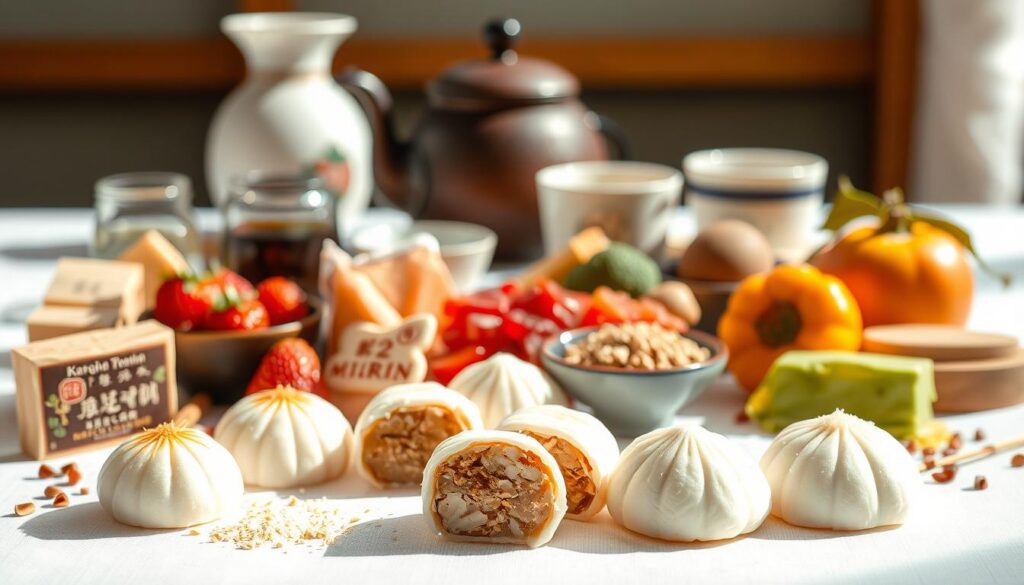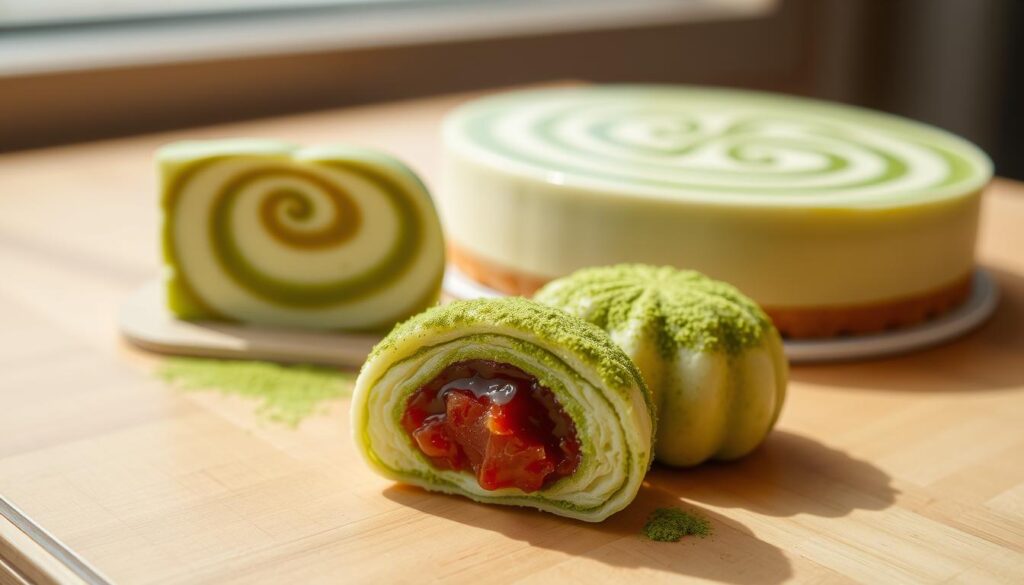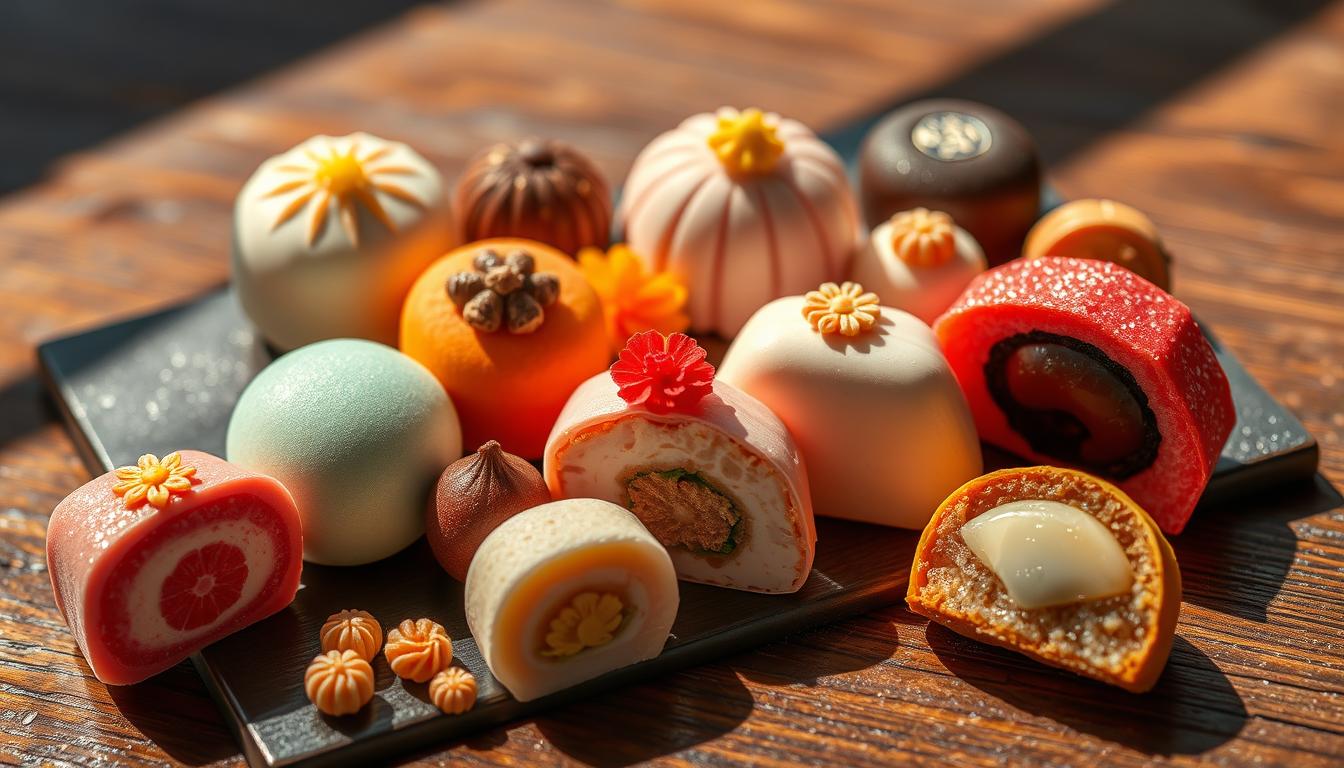Traditional japanese desserts recipe : Exploring traditional Japanese desserts was like finding a treasure trove of culinary wonders. The mix of flavors and the way they’re made is truly magical. These sweets are not just food; they’re a window into Japan’s rich history and culture.
Trying authentic Japanese sweets is a journey unlike any other. You’ll experience the softness of mochi and the gentle taste of matcha. These desserts let you taste Japan’s heritage right in your kitchen. Whether you love food or enjoy cooking, these recipes will take you on a trip through Japanese culinary traditions.
Key Takeaways
- Discover the unique ingredients that make Japanese desserts special
- Learn traditional preparation techniques used in Japanese sweet-making
- Explore desserts that blend centuries-old recipes with modern flavors
- Understand the cultural significance behind each sweet treat
- Master simple yet elegant dessert recipes from Japan
Understanding Japanese Dessert Culture and Traditions
Japanese desserts are more than just sweet treats. They are a form of culinary art deeply rooted in culture. Wagashi recipes and traditional Japanese delicacies show centuries of artistic and culinary growth.
These sweets have a history of over 800 years, starting in the Heian period. They are not just food but a way to connect generations through taste and art.
The Cultural Significance of Wagashi
Wagashi have many roles in Japanese society. They are important in:
- Traditional tea ceremonies
- Seasonal celebrations
- Social gatherings
- Artistic expression
Seasonal Ingredients and Variations
Each season brings new wagashi varieties. These sweets change with the seasons, offering unique flavors and designs.
| Season | Typical Wagashi | Key Ingredients |
|---|---|---|
| Spring | Sakura Mochi | Rice flour, Cherry blossom leaves |
| Summer | Mizumochi | Agar, Fruit jellies |
| Autumn | Kuri Manju | Chestnuts, Sweet bean paste |
| Winter | Yuzu Mochi | Glutinous rice, Citrus |
Craftsmanship and Preparation
Making wagashi recipes is a skill that takes years to learn. Wagashi-shi, the artisans, train for 5-10 years. Their hard work makes each piece a small art piece.
Learning about these traditional Japanese sweets shows the deep bond between food, art, and culture in Japanese cuisine.
Essential Kitchen Tools and Equipment for Traditional Japanese Desserts Recipe
To make authentic traditional Japanese desserts, you need special kitchen tools. These tools are different from what you use for baking. They help you make delicate sweets just like in Japan.
Here are the key tools for making traditional Japanese desserts:
- Wooden Hangiri (rice mixing bowl) for preparing mochi and other rice-based desserts
- Bamboo rolling mats for shaping delicate pastries
- Precise measuring tools like the Measuring Miso Whisk Muddler & Handy Strainer Set
- Japanese mandoline for creating uniform ingredient slices
- Specialized whisks for mixing batters and creating smooth textures
When picking tools for Japanese confectionery, look for quality and authenticity. Tools like the Umezawa Sawara Cypress Hangiri ($129.00) or the Natural Bamboo Sushi Rolling Mat ($14.99) can make a big difference.
If you’re on a budget, don’t worry. You can still make traditional desserts with common tools. The trick is to know what each tool does and find ways to use what you already have.
Pro tip: Spend on a few key tools that will really help your desserts. A good Santoku knife (around $199.00) and precise measuring tools can make a big difference.
Key Ingredients for Authentic Japanese Confectionery
Making traditional Japanese desserts means knowing the special ingredients. Japanese sweets have unique flavors and ingredients. These turn simple recipes into amazing dishes.

Japanese desserts start with special ingredients. Each one adds a unique taste and depth. These ingredients have delighted people for many years.
Types of Rice Flour in Japanese Sweets
Rice flour is key in Japanese sweets. Different types give different textures and qualities:
- Mochiko: Glutinous rice flour for chewy mochi
- Shiratamako: Fine rice flour for delicate desserts
- Joshinko: Non-glutinous rice flour for various recipes
Traditional Sweeteners and Flavorings
Japanese sweets use special sweeteners for their taste:
- Mizuame: A mild, sticky sugar syrup
- Wasanbon: Refined sugar with a light taste
- Kuromitsu: Black sugar syrup with deep flavors
Special Japanese Ingredients
Some ingredients make Japanese desserts special:
- Matcha: Powdered green tea for depth
- Kinako: Roasted soybean flour with nutty taste
- Yuzu: Citrus fruit for bright, aromatic notes
- Black sesame: Rich, nutty flavors and looks
Knowing these ingredients lets you make authentic Japanese sweets at home. You can bring the essence of Japanese cooking into your kitchen.
Mastering Mochi: Step-by-Step Guide
Mochi is a beloved traditional Japanese dessert loved by many. These rice cakes are not just a treat but a cultural experience. They bring together centuries of culinary tradition. If you’re eager to explore authentic mochi dessert recipes, you’re in for an exciting culinary journey.
To create perfect mochi, you’ll need some essential ingredients and techniques. Here’s a breakdown of what makes these traditional Japanese desserts recipe so special:
- Glutinous rice flour (sweet rice flour)
- Water
- Sugar
- Cornstarch for dusting
The key to authentic mochi lies in the preparation method. Traditionally, Japanese artisans would pound glutinous rice using large wooden mallets in a process called mochitsuki. Modern home cooks can achieve similar results using more accessible techniques.
Your mochi-making adventure involves several crucial steps:
- Mix glutinous rice flour with water and sugar
- Steam the mixture until it becomes a sticky, uniform paste
- Knead the dough thoroughly
- Shape into small, delicate cakes
- Dust with cornstarch to prevent sticking
Pro tip: Work quickly when handling mochi, as the dough becomes less pliable as it cools. The ideal mochi should be soft, chewy, and have a delicate shine that reflects its careful preparation.
Mochi is more than a dessert—it’s a celebration of Japanese culinary artistry and seasonal traditions.
Whether you’re preparing mochi for a special occasion or simply exploring traditional Japanese desserts recipe, patience and practice will help you master this delightful sweet treat.
Creating Perfect Dorayaki Pancakes
Dorayaki is a traditional Japanese dessert loved worldwide. It’s known for its fluffy pancakes and sweet filling. This treat has a long history, dating back to the Edo period. It became famous thanks to anime.
Making dorayaki pancakes needs skill and precision. Knowing the key ingredients is crucial for success in this recipe.
Ingredient Breakdown for Authentic Dorayaki
- 1 cup all-purpose flour
- 1/4 cup granulated sugar
- 1/2 tablespoon baking powder
- 2 large eggs
- 1/4 cup water
- 1 1/2 teaspoons honey
Perfect Pancake Batter Technique
Mixing the batter for dorayaki is important. Use eggs at room temperature and mix gently. This avoids making the pancakes dense. Let the batter rest for 10-15 minutes. This step makes the pancakes light and fluffy.
Sweet Red Bean Filling Preparation
The classic filling for dorayaki is azuki bean paste. But, you can also use other sweet fillings like:
- Hazelnut cream
- Chocolate spread
- Matcha cream
- Fruit jams
- Custard
Cooking and Assembly Techniques
Cook dorayaki on low to medium heat. Wait for bubbles to form before flipping. Cook each side for about 3 minutes on the first side and 1 minute on the second.
| Cooking Stage | Time | Temperature |
|---|---|---|
| First Side | 3 minutes | Low-Medium |
| Second Side | 1 minute | Low-Medium |
Let the pancakes cool a bit before adding the filling. Place the filling between two pancakes. This creates the iconic dorayaki shape, like a traditional Japanese gong.
Crafting Traditional Matcha Desserts

Matcha sweets are the top of authentic Japanese sweets. They mix flavor and tradition in a unique way. This green tea powder turns simple desserts into amazing experiences that show off Japanese cuisine.
Exploring matcha desserts opens a world of tasty recipes. These recipes show how versatile this amazing ingredient is. Here are some popular matcha treats you can make at home:
- Matcha Nama Chocolate (requires only 4 ingredients)
- Matcha Warabi Mochi made with special bracken starch
- Matcha Cookies with white chocolate chunks
- Matcha Dorayaki with traditional red bean paste
- Light and fluffy Matcha Roll Cake
The secret to great matcha sweets is using top-notch powder. Ceremonial-grade matcha from Kyoto’s Uji region has the finest taste. It’s sweet but also has a hint of bitterness.
Here are some tips for using matcha:
- Sift the matcha powder to prevent clumping
- Use a bamboo whisk for the best texture
- Store matcha in an airtight container away from light
- Choose fresh, vibrant green powder for the best results
Whether you’re making traditional wagashi or modern matcha desserts, this ingredient will boost your cooking skills. It will take your taste buds on a journey to the heart of Japanese sweet-making traditions.
Making Classic Japanese Coffee Jelly
Japanese coffee jelly is a unique treat in traditional Japanese desserts. It shows the creativity of Japanese sweets. This dessert started in Japan’s coffee boom of the 1960s. It quickly became popular in cafés and homes.
Coffee jelly is a refreshing twist on traditional desserts. It mixes the deep taste of coffee with a light, jiggly texture. Its bold flavor is loved by coffee fans and dessert lovers alike.
Coffee Selection Tips
Choosing the right coffee is key for a true Japanese coffee jelly experience. Here are some tips:
- Use strong black coffee for the best flavor
- Choose freshly brewed coffee over instant
- Try different roast levels to find your favorite
Gelatin Setting Techniques
Getting the gelatin right is important for the perfect texture. Here’s how to get it just right:
- Start with 1 tablespoon of unflavored gelatin powder
- Mix it with 1/4 cup of water carefully
- Let it set in the fridge for 5 hours
“A perfect coffee jelly should wobble slightly and melt smoothly on your tongue” – Japanese Dessert Chef
Pro tip: For a vegetarian option, use agar-agar instead of gelatin. It sets like gelatin but is plant-based.
Preparing Authentic Kasutera (Castella Cake)
Learn to make traditional Japanese delicacies with this Castella cake recipe. It comes from Nagasaki in the 16th century. This sweet tells a story of cultural exchange between Portugal and Japan.
Castella is a mix of Portuguese and Japanese baking. It needs careful work to get its smooth texture and golden crust.
Key Ingredients for Perfect Castella
- 100g bread flour
- 20g cake flour
- 4 eggs (3 whites, 4 yolks)
- 120g white caster sugar
- 40g honey
- 30ml whole milk
- 30ml cooking oil
Baking Process
- Preheat oven to 180°C (356°F)
- Mix eggs and sugar well
- Slowly add flour
- Pour into an 18cm square pan
- Lower oven to 160°C (320°F) while baking
Storing Castella right keeps it moist. Keep it at room temperature for 3-4 days in cool places. Or refrigerate for up to a week. Freeze for a month to keep it longer.
| Flavor Variation | Seasonal Availability |
|---|---|
| Matcha Castella | Year-round |
| Sakura Castella | Spring |
| Sweet Potato Castella | Autumn |
| Strawberry Castella | Winter |
Pro tip: Let your Castella rest for 24 hours after baking. This makes it more moist and flavorful. It’s a traditional way to make your Castella taste like Nagasaki’s best.
Homemade Dango: A Traditional Japanese Sweet
Dango is a beloved traditional Japanese dessert. It’s a rice flour dumpling that’s a staple in Japanese sweets. It has delighted many for generations.
Dango is a classic Japanese street food and festival treat. It’s simple yet flavorful. Making it involves special techniques that turn basic ingredients into tasty treats.
Shaping and Cooking Techniques
Making perfect dango takes precision and practice. Here’s how to make these traditional treats:
- Mix glutinous rice flour with water to create a smooth dough
- Roll the dough into small balls approximately 2 cm in diameter
- Boil the dango for 3-5 minutes until they float
- Remove and cool before skewering
Popular Dango Variations
Dango has exciting flavor profiles. It shows the diversity of Japanese desserts:
| Dango Type | Characteristics | Flavor Profile |
|---|---|---|
| Mitarashi Dango | Sweet soy glaze coating | Savory-sweet balance |
| Hanami Dango | Tri-color presentation | Subtle, delicate flavors |
| Anko Dango | Red bean paste topping | Rich, traditional sweetness |
When making dango, remember each skewer has 3-5 dumplings. Use 50% joshinko and 50% shiratamako for the right texture.
Pro tip: Store your homemade dango in an airtight container. Eat it the same day for the best taste.
Tips for Achieving Perfect Texture and Flavor
Creating authentic Japanese sweets needs precision and knowledge of traditional ingredients. The secret to making great Japanese desserts is in the technique and choosing the right ingredients.
To make perfect Japanese desserts, you need to master several key techniques:
- Control moisture levels carefully
- Use precise temperature management
- Select high-quality ingredients
- Practice consistent mixing techniques
Temperature is very important for the right texture. For example, soufflé cheesecake needs specific baking stages:
| Stage | Temperature | Duration |
|---|---|---|
| Initial Baking | 150°C (302°F) | 30 minutes |
| Secondary Baking | 110°C (230°F) | 40 minutes |
| Final Stage | 130°C (266°F) | 10 minutes |
When using traditional Japanese dessert ingredients, watch out for egg whites. Properly whipped egg whites are critical – mixing them too little or too much can change your dessert’s texture a lot.
Professional bakers suggest using full-fat, high-quality cream cheese and measuring ingredients carefully. Baking in a water bath helps keep moisture in and prevents cracks. This ensures your Japanese sweets have the perfect, delicate texture.
Storage and Preservation Methods for Japanese Desserts
Keeping the flavors and textures of traditional Japanese desserts fresh is key. Each type of Japanese confectionery needs its own storage method. This helps keep their special qualities and stops them from spoiling.
Here are some important tips for storing your homemade Japanese sweets:
- Namagashi (Moist Sweets): These delicate treats have the shortest shelf life, typically 1-2 days when refrigerated
- Hannamagashi (Semi-Fresh Sweets): Can be stored at room temperature for several days to a week
- Higashi (Dry Sweets): Best preserved at room temperature for up to one month
For the best storage of your Japanese confectionery, remember these tips:
- Always use airtight containers to prevent moisture and air exposure
- Wrap individual desserts separately to maintain their unique texture
- Refrigerate moist desserts immediately after preparation
- Consume seasonal desserts within their recommended storage time
Seasonal treats need special care. Spring desserts like sakura mochi have different storage needs than winter treats like yukishiro. Knowing these differences helps keep your desserts fresh and tasty.
Pro tip: Never open packaged wagashi until you’re ready to serve, as exposure can quickly compromise their delicate texture and flavor.
Conclusion
Your journey into authentic Japanese sweets shows a tradition over 1,200 years old. The recipes you’ve seen are more than tasty treats. They are edible art that shows centuries of culture and skill.
Learning to make these sweets connects you to a deep food history. Wagashi from the Nara period to today’s mix of old and new flavors tell Japan’s food story. These sweets are not just desserts. They show the seasons, local traditions, and the art of making sweets.
When you try these recipes, it’s not just about following steps. It’s about patience, knowing your ingredients, and finding the right flavors. Making mochi, dorayaki, or warabi mochi is joining a tradition passed down through generations.
Your new skills let you bring Japanese food culture into your kitchen. Every dessert you make celebrates tradition, creativity, and the beauty of Japanese sweets.
FAQ
What are wagashi, and why are they important in Japanese culture?
What are the most common ingredients in traditional Japanese desserts?
Is it difficult to make Japanese desserts at home?
Where can I find authentic Japanese dessert ingredients?
How long can homemade Japanese desserts be stored?
Are Japanese desserts typically very sweet?
Can I substitute ingredients if I can’t find authentic Japanese products?
What’s the difference between mochi and dango?
Are Japanese desserts typically vegetarian or vegan?
What equipment do I need to make Japanese desserts at home?
Try Thes Recipes Next!
if you’re looking for more delicious recipes, check out our guide for another
crowed-pleasing dish

